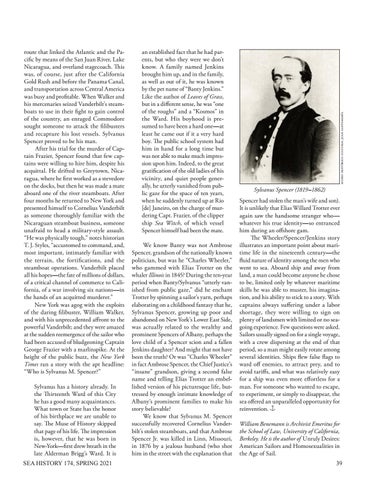Sylvanus has a history already. In the Thirteenth Ward of this City he has a good many acquaintances. What town or State has the honor of his birthplace we are unable to say. The Muse of History skipped that page of his life. The impression is, however, that he was born in New-York—first drew breath in the late Alderman Brigg’s Ward. It is
an established fact that he had parents, but who they were we don’t know. A family named Jenkins brought him up, and in the family, as well as out of it, he was known by the pet name of “Banty Jenkins.” Like the author of Leaves of Grass, but in a different sense, he was “one of the roughs” and a “Kosmos” in the Ward. His boyhood is presumed to have been a hard one—at least he came out if it a very hard boy. The public school system had him in hand for a long time but was not able to make much impression upon him. Indeed, to the great gratification of the old ladies of his vicinity, and quiet people generally, he utterly vanished from public gaze for the space of ten years, when he suddenly turned up at Rio [de] Janeiro, on the charge of murdering Capt. Frazier, of the clipper ship Sea Witch, of which vessel Spencer himself had been the mate. We know Banty was not Ambrose Spencer, grandson of the nationally known politician, but was he “Charles Wheeler,” who gammed with Elias Trotter on the whaler Illinois in 1845? During the ten-year period when Banty/Sylvanus “utterly vanished from public gaze,” did he enchant Trotter by spinning a sailor’s yarn, perhaps elaborating on a childhood fantasy that he, Sylvanus Spencer, growing up poor and abandoned on New York’s Lower East Side, was actually related to the wealthy and prominent Spencers of Albany, perhaps the love child of a Spencer scion and a fallen Jenkins daughter? And might that not have been the truth? Or was “Charles Wheeler” in fact Ambrose Spencer, the Chief Justice’s “insane” grandson, giving a second false name and telling Elias Trotter an embellished version of his picturesque life, buttressed by enough intimate knowledge of Albany’s prominent families to make his story believable? We know that Sylvanus M. Spencer successfully recovered Cornelius Vanderbilt’s stolen steamboats, and that Ambrose Spencer Jr. was killed in Linn, Missouri, in 1876 by a jealous husband (who shot him in the street with the explanation that
museo histórico cultural juan santamaría
route that linked the Atlantic and the Pacific by means of the San Juan River, Lake Nicaragua, and overland stagecoach. This was, of course, just after the California Gold Rush and before the Panama Canal, and transportation across Central America was busy and profitable. When Walker and his mercenaries seized Vanderbilt’s steamboats to use in their fight to gain control of the country, an enraged Commodore sought someone to attack the filibusters and recapture his lost vessels. Sylvanus Spencer proved to be his man. After his trial for the murder of Captain Frazier, Spencer found that few captains were willing to hire him, despite his acquittal. He drifted to Greytown, Nicaragua, where he first worked as a stevedore on the docks, but then he was made a mate aboard one of the river steamboats. After four months he returned to New York and presented himself to Cornelius Vanderbilt as someone thoroughly familiar with the Nicaraguan steamboat business, someone unafraid to head a military-style assault. “He was physically tough,” notes historian T. J. Styles, “accustomed to command, and, most important, intimately familiar with the terrain, the fortifications, and the steamboat operations. Vanderbilt placed all his hopes—the fate of millions of dollars, of a critical channel of commerce to California, of a war involving six nations—in the hands of an acquitted murderer.” New York was agog with the exploits of the daring filibuster, William Walker, and with his unprecedented affront to the powerful Vanderbilt; and they were amazed at the sudden reemergence of the sailor who had been accused of bludgeoning Captain George Frazier with a marlinspike. At the height of the public buzz, the New York Times ran a story with the apt headline: “Who is Sylvanus M. Spencer?”
Sylvanus Spencer (1819–1862) Spencer had stolen the man’s wife and son). It is unlikely that Elias Willard Trotter ever again saw the handsome stranger who— whatever his true identity—so entranced him during an offshore gam. The Wheeler/Spencer/Jenkins story illustrates an important point about maritime life in the nineteenth century—the fluid nature of identity among the men who went to sea. Aboard ship and away from land, a man could become anyone he chose to be, limited only by whatever maritime skills he was able to muster, his imagination, and his ability to stick to a story. With captains always suffering under a labor shortage, they were willing to sign on plenty of landsmen with limited or no seagoing experience. Few questions were asked. Sailors usually signed on for a single voyage, with a crew dispersing at the end of that period, so a man might easily rotate among several identities. Ships flew false flags to ward off enemies, to attract prey, and to avoid tariffs, and what was relatively easy for a ship was even more effortless for a man. For someone who wanted to escape, to experiment, or simply to disappear, the sea offered an unparalleled opportunity for reinvention. William Benemann is Archivist Emeritus for the School of Law, University of California, Berkeley. He is the author of Unruly Desires: American Sailors and Homosexualities in the Age of Sail.
SEA HISTORY 174, SPRING 2021 39
